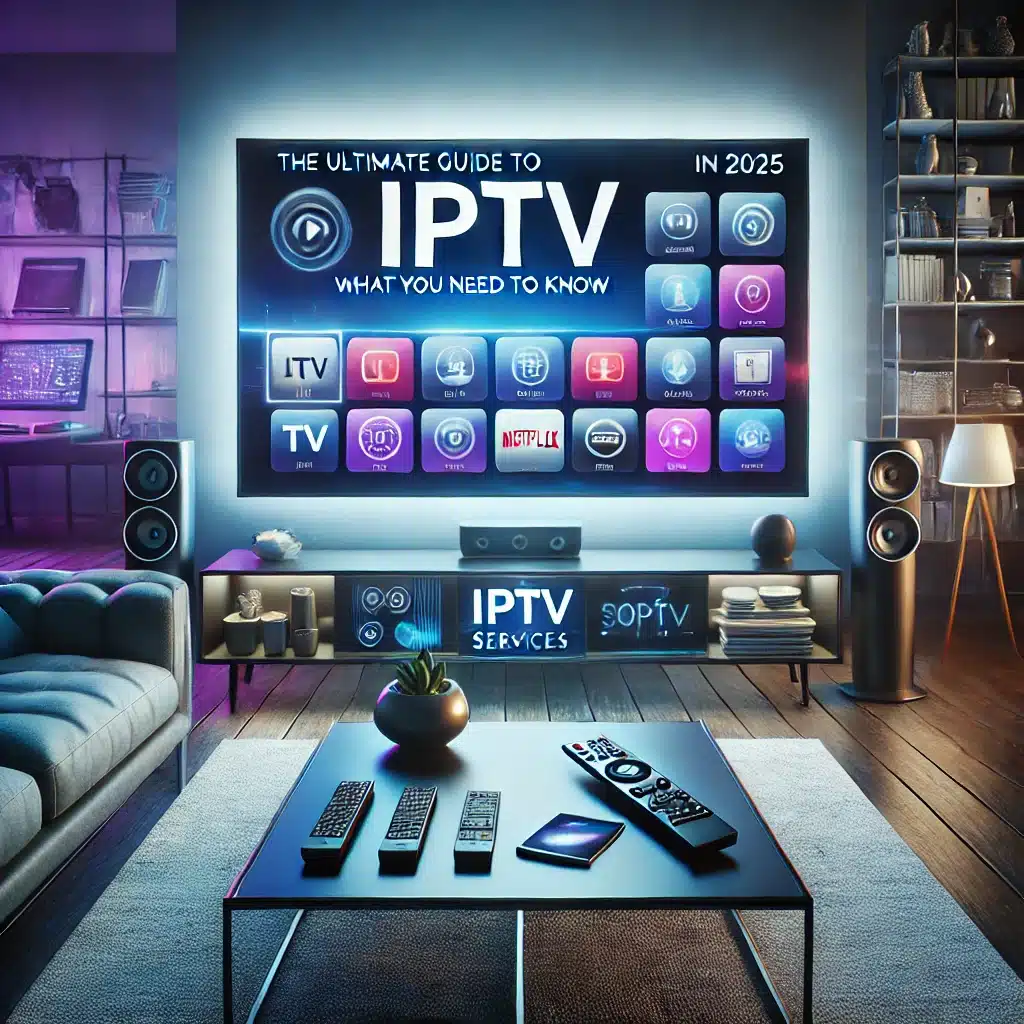| Main Topic | Subtopics |
|---|---|
| 1. Introduction to IPTV | 1.1 What is IPTV? 1.2 How IPTV Works: The Technical Overview 1.3 IPTV vs Traditional TV: What’s the Difference? |
| 2. Types of IPTV Services | 2.1 Video on Demand (VOD) Explained 2.2 Live IPTV Broadcasting 2.3 Time-Shifted Media 2.4 Catch-Up TV and Start-Over TV |
| 3. IPTV Technology | 3.1 IPTV Protocols and Standards (RTSP, HTTP, etc.) 3.2 Streaming Media Formats for IPTV (HLS, MPEG-DASH) 3.3 Multicasting vs Unicasting in IPTV |
| 4. IPTV Devices | 4.1 IPTV Set-Top Boxes: Overview and Features 4.2 Smart TVs and IPTV Integration 4.3 Mobile Devices and Tablets for IPTV Viewing 4.4 IPTV on PCs and Laptops |
| 5. IPTV Platforms and Apps | 5.1 Popular IPTV Service Providers in 2025 5.2 IPTV Apps for Android and iOS 5.3 IPTV Add-Ons for Streaming Platforms (Kodi, Plex, etc.) |
| 6. Legal Considerations for IPTV | 6.1 Is IPTV Legal? Understanding the Legalities 6.2 Licensed vs Unlicensed IPTV Services 6.3 Avoiding IPTV Scams and Illegal Streams |
| 7. IPTV Subscriptions and Pricing | 7.1 How Much Does IPTV Cost? 7.2 Subscription-Based IPTV vs Free IPTV Services 7.3 Regional Pricing and Availability of IPTV Services |
| 8. Internet Requirements for IPTV | 8.1 Minimum Bandwidth for IPTV Streaming 8.2 Fiber vs DSL vs Cable: Which Internet Connection Is Best? 8.3 Buffering Issues and How to Avoid Them |
| 9. IPTV Content and Channels | 9.1 Types of Channels Available on IPTV 9.2 Niche and International Channels 9.3 Sports and Live Event Coverage on IPTV |
| 10. IPTV Security and Privacy | 10.1 Data Privacy Concerns with IPTV 10.2 VPN Usage for IPTV: Is It Necessary? 10.3 Cybersecurity Threats in IPTV Streaming |
| 11. IPTV for Businesses and Enterprises | 11.1 IPTV for Hotels and Hospitality 11.2 IPTV in Corporate Settings 11.3 IPTV in Education and Training |
| 12. IPTV and Advertising | 12.1 How Ads Work on IPTV Platforms 12.2 Targeted Advertising and Data Collection 12.3 The Future of Ad-Free IPTV Services |
| 13. The Future of IPTV | 13.1 IPTV and the Rise of 5G Streaming 13.2 Cloud-Based IPTV Solutions 13.3 Innovations in AI and Personalized Content on IPTV |
| 14. Pros and Cons of IPTV | 14.1 Advantages of IPTV Over Traditional TV 14.2 Drawbacks and Limitations of IPTV 14.3 How IPTV Is Shaping the Future of Television |
| 15. Frequently Asked Questions (FAQs) | 15.1 How Can I Access IPTV? 15.2 What Are the Best IPTV Providers in 2025? 15.3 What Are the Internet Speed Requirements for IPTV? 15.4 Is IPTV Better Than Cable TV? 15.5 Are IPTV Services Safe to Use? 15.6 How Can I Improve IPTV Streaming Quality? |
The Ultimate Guide to IPTV: What You Need to Know in 2025
The world of television and media consumption has changed dramatically over the past decade, and IPTV (Internet Protocol Television) has played a significant role in this transformation. As we enter 2025, IPTV continues to evolve, offering more options, higher-quality content, and a richer viewing experience than ever before. In this comprehensive guide, we’ll explore everything you need to know about IPTV, from how it works to the legal considerations, pricing models, and the future of the industry. Whether you’re a potential user or simply curious, this guide has you covered.
1. Introduction to IPTV
1.1 What is IPTV?
IPTV, or Internet Protocol Television, refers to the delivery of television content over the internet rather than through traditional satellite, cable, or terrestrial formats. This technology allows users to stream live TV, on-demand shows, and other media directly to their devices without the need for traditional TV broadcasting methods.
IPTV differs from standard online video platforms (like YouTube or Netflix) in that it provides continuous streaming of television channels, similar to what traditional broadcasters offer, but over IP networks.
1.2 How IPTV Works: The Technical Overview
At its core, IPTV uses the Internet Protocol (IP) to deliver TV programs and videos to viewers. The system relies on IP networks to send TV signals, which can then be viewed on a variety of devices. Unlike traditional television that broadcasts a signal, IPTV transmits data packets through IP for each video stream, meaning each user can have an entirely different experience even while using the same service.
The key components of IPTV include:
- Content Source: Channels and media provided by broadcasters.
- IPTV Middleware: Software that bridges the gap between the user and the service provider.
- Video on Demand (VoD): Allows viewers to select specific programs to watch at their convenience.
- Streaming Servers: Handle the transmission of data across the network to viewers.
1.3 IPTV vs Traditional TV: What’s the Difference?
While traditional television is limited by broadcast schedules and geographical limitations, IPTV offers on-demand access to media from virtually anywhere. The key differences include:
- Flexibility: IPTV allows time-shifted viewing, meaning users can watch programs whenever they want, unlike traditional TV that follows a fixed schedule.
- Interactivity: IPTV enables interactive services, such as live pause, play, and recording.
- Variety: With IPTV, viewers have access to a wider variety of channels and media, often at lower prices.
2. Types of IPTV Services
2.1 Video on Demand (VOD) Explained
Video on Demand (VOD) is one of the most popular types of IPTV services. VOD allows users to choose and watch videos from a large content library at their convenience. The content can include movies, TV shows, documentaries, and more. Unlike live TV broadcasts, VOD services store the content on servers and deliver it on demand.
Some popular VOD services include Netflix, Hulu, and Amazon Prime Video, which operate on the same principle but are not considered IPTV, as they don’t offer live TV channels.
2.2 Live IPTV Broadcasting
Live IPTV broadcasting streams TV channels in real-time, allowing viewers to watch news, sports, and events as they happen. It mimics the traditional TV experience but over the internet, offering higher flexibility as users can access the content across multiple devices.
Popular services like Sling TV, YouTube TV, and fuboTV offer live broadcasting as part of their IPTV service lineup.
2.3 Time-Shifted Media
Time-shifted media allows viewers to watch content after it has been broadcast. Catch-Up TV is a common example, where users can access a show for a limited period after its initial airing. This is especially useful for live events that viewers may have missed due to time zone differences or schedule conflicts.
2.4 Catch-Up TV and Start-Over TV
Catch-Up TV enables viewers to watch previously aired shows from the past hours or days, while Start-Over TV allows users to restart a live show from the beginning if they missed the initial part of it. These features give users more control over their viewing experience compared to traditional TV.
3. IPTV Technology
3.1 IPTV Protocols and Standards (RTSP, HTTP, etc.)
IPTV services rely on several different protocols to transmit data. The most common ones include:
- RTSP (Real-Time Streaming Protocol): Manages the streaming of live and recorded media.
- HTTP (Hypertext Transfer Protocol): Used for on-demand content and catch-up TV, particularly for VOD.
- HLS (HTTP Live Streaming): A protocol developed by Apple that segments video streams into small chunks for smoother delivery.
These protocols ensure that IPTV content is streamed seamlessly, regardless of the user’s device or internet connection.
3.2 Streaming Media Formats for IPTV (HLS, MPEG-DASH)
IPTV services use various media formats for delivering content. The two most common formats are:
- HLS (HTTP Live Streaming): Developed by Apple, it’s widely used for live streaming.
- MPEG-DASH (Dynamic Adaptive Streaming over HTTP): This format adapts the video quality to the user’s internet bandwidth, providing the best possible viewing experience.
3.3 Multicasting vs Unicasting in IPTV
In IPTV, there are two primary methods for delivering content:
- Multicasting: A single stream is sent to multiple users, ideal for live broadcasts with a large audience.
- Unicasting: A separate stream is sent to each user, which is typical for VOD services.
4. IPTV Devices
4.1 IPTV Set-Top Boxes: Overview and Features
IPTV set-top boxes are devices that connect your television to an IPTV service. They convert digital signals into a format that can be displayed on your TV. Popular IPTV set-top boxes include:
- Amazon Fire TV Stick
- Apple TV
- NVIDIA Shield These devices allow users to access IPTV content through a dedicated app or software.
4.2 Smart TVs and IPTV Integration
Smart TVs often come with built-in apps that support IPTV, eliminating the need for an external device. Brands like Samsung, LG, and Sony offer IPTV-compatible smart TVs, making it easier than ever to stream your favorite content directly.
4.3 Mobile Devices and Tablets for IPTV Viewing
IPTV services are highly compatible with mobile devices and tablets, allowing users to stream content on the go. Whether on iOS or Android, most IPTV providers offer dedicated apps for mobile streaming.
4.4 IPTV on PCs and Laptops
For users who prefer watching content on their computers, IPTV services can be accessed via web browsers or specialized software such as VLC media player or Kodi.
5. IPTV Platforms and Apps
5.1 Popular IPTV Service Providers in 2025
In 2025, there are numerous IPTV service providers offering a variety of content. Some of the most popular include:
- MySmarters IPTV
- Smarters IPTV These platforms offer live TV, VOD, and time-shifted media as part of their services.
5.2 IPTV Apps for Android and iOS
There are countless IPTV apps available for mobile devices, with some of the best being:
- IPTV Smarters Pro
- GSE Smart IPTV
- TiviMate These apps allow users to load IPTV playlists and watch live TV or VOD content on their mobile devices.
5.3 IPTV Add-Ons for Streaming Platforms (Kodi, Plex, etc.)
Popular streaming platforms like Kodi and Plex offer IPTV add-ons that enable users to stream live TV through their interfaces. These add-ons allow for a more customizable viewing experience.
6. Legal Considerations for IPTV
6.1 Is IPTV Legal? Understanding the Legalities
IPTV as a technology is legal, but not all IPTV services operate within the law. Some services offer unauthorized streams of copyrighted content, which can lead to legal consequences for both providers and users.
6.2 Licensed vs Unlicensed IPTV Services
Licensed IPTV services operate with the necessary permissions from content creators and broadcasters. Unlicensed services often stream content illegally without paying for the rights, making them illegal in many countries.
6.3 Avoiding IPTV Scams and Illegal Streams
Illegal IPTV services often come with risks, including poor streaming quality, data breaches, and even legal action. Always verify that the IPTV service you are using is licensed and reputable.
7. IPTV Subscriptions and Pricing
7.1 How Much Does IPTV Cost?
IPTV pricing varies depending on the service provider, content offering, and region. In 2025, prices typically range from $10 to $70 per month, depending on the package and additional services such as premium sports or movie channels.
7.2 Subscription-Based IPTV vs Free IPTV Services
Subscription-based IPTV services generally offer better quality, more reliable streams, and licensed content. Free IPTV services may provide limited channels, lower quality, and come with the risk of illegal streaming.
7.3 Regional Pricing and Availability of IPTV Services
IPTV service pricing often depends on the region due to licensing agreements. In some countries, certain content may not be available due to geo-restrictions or local broadcasting laws.
8. Internet Requirements for IPTV
8.1 Minimum Bandwidth for IPTV Streaming
For IPTV, a reliable internet connection is essential. The minimum bandwidth required for IPTV varies depending on the quality of the stream:
- SD quality: 3-5 Mbps
- HD quality: 5-10 Mbps
- 4K/UHD quality: 25 Mbps or more
8.2 Fiber vs DSL vs Cable: Which Internet Connection Is Best?
Fiber-optic internet is the best option for IPTV, providing the fastest speeds and most reliable connection. Cable internet is a good alternative, while DSL may struggle to provide enough bandwidth for high-quality IPTV streaming.
8.3 Buffering Issues and How to Avoid Them
Buffering can be a major issue with IPTV, especially if the internet connection is slow or unstable. To minimize buffering:
- Ensure you have sufficient bandwidth.
- Use a wired Ethernet connection instead of Wi-Fi.
- Reduce the number of devices connected to your network.
9. IPTV Content and Channels
9.1 Types of Channels Available on IPTV
IPTV offers a wide range of channels, including:
- News Channels: CNN, BBC, Al Jazeera
- Sports Channels: ESPN, Sky Sports, beIN Sports
- Entertainment Channels: HBO, AMC, FX
9.2 Niche and International Channels
One of the advantages of IPTV is the ability to access niche and international channels that may not be available through traditional TV providers. This includes language-specific content and international sports events.
9.3 Sports and Live Event Coverage on IPTV
IPTV has become a popular choice for sports fans, offering coverage of live events from around the world. Many IPTV providers offer premium sports packages, including access to pay-per-view events and exclusive sports channels.
10. IPTV Security and Privacy
10.1 Data Privacy Concerns with IPTV
Since IPTV streams content over the internet, there are concerns about data privacy. IPTV providers may collect personal data such as viewing habits and device information, which could be used for advertising or sold to third parties.
10.2 VPN Usage for IPTV: Is It Necessary?
A Virtual Private Network (VPN) can help protect your privacy while using IPTV by encrypting your data and hiding your location. It can also be useful for accessing geo-restricted content on IPTV services.
10.3 Cybersecurity Threats in IPTV Streaming
Unlicensed IPTV services are more likely to expose users to cybersecurity threats, including malware and phishing attacks. Always choose a trusted and secure IPTV provider to avoid these risks.
11. IPTV for Businesses and Enterprises
11.1 IPTV for Hotels and Hospitality
Many hotels now offer IPTV services to enhance the guest experience. IPTV allows hotels to offer a wider range of content, including on-demand movies, local and international channels, and personalized entertainment options.
11.2 IPTV in Corporate Settings
IPTV is increasingly being used in corporate environments for training, internal communications, and live events. It allows businesses to stream live conferences, training sessions, and company announcements to employees across the globe.
11.3 IPTV in Education and Training
Educational institutions are adopting IPTV to deliver lectures, tutorials, and training materials to students. This is especially useful for distance learning, where students can access educational content on demand.
12. IPTV and Advertising
12.1 How Ads Work on IPTV Platforms
IPTV platforms often use dynamic ad insertion, where ads are tailored to the viewer’s interests and location. This offers a more personalized advertising experience compared to traditional TV.
12.2 Targeted Advertising and Data Collection
IPTV providers can collect data on viewer behavior, allowing for highly targeted advertising. However, this raises privacy concerns, as users may not be aware of how much of their data is being collected and used for ad purposes.
12.3 The Future of Ad-Free IPTV Services
As more viewers opt for ad-free experiences, some IPTV services offer premium plans that allow users to watch content without interruptions from ads. These plans typically come at a higher price but provide a seamless viewing experience.
13. The Future of IPTV
13.1 IPTV and the Rise of 5G Streaming
The introduction of 5G networks is set to revolutionize IPTV by enabling faster, more reliable streaming. With 5G, IPTV providers can offer higher-quality streams, reduced latency, and improved mobile viewing experiences.
13.2 Cloud-Based IPTV Solutions
Cloud-based IPTV solutions are becoming more popular, allowing providers to offer scalable, on-demand services without the need for costly infrastructure. This trend is expected to continue growing in 2025 and beyond.
13.3 Innovations in AI and Personalized Content on IPTV
Artificial Intelligence (AI) is playing a larger role in IPTV, with providers using AI to offer personalized content recommendations based on viewing habits. AI also helps optimize streaming quality by predicting bandwidth requirements and adjusting accordingly.
14. Pros and Cons of IPTV
14.1 Advantages of IPTV Over Traditional TV
- Flexibility: IPTV allows viewers to watch content whenever they want, on a wide range of devices.
- Cost-Effective: IPTV services are often more affordable than cable or satellite TV subscriptions.
- Content Variety: IPTV offers access to a broader range of channels, including international and niche content.
14.2 Drawbacks and Limitations of IPTV
- Dependence on Internet Connection: IPTV requires a strong, reliable internet connection, which may not be available in all areas.
- Legal Risks: Some IPTV services may operate in a legal gray area, exposing users to potential legal issues.
- Quality Issues: Poor internet connections can lead to buffering, lower resolution, and interruptions in service.
14.3 How IPTV Is Shaping the Future of Television
IPTV is driving the future of television by offering more flexibility, personalization, and accessibility than traditional broadcasting methods. With the rise of 5G and AI, IPTV is expected to continue innovating and transforming the way we consume media.
15. Frequently Asked Questions (FAQs)
15.1 How Can I Access IPTV?
IPTV can be accessed through a variety of devices, including smart TVs, set-top boxes, smartphones, tablets, and PCs. You’ll need an internet connection and a subscription to an IPTV service.
15.2 What Are the Best IPTV Providers in 2025?
Some of the best IPTV providers in 2025 include MySmarters IPTV Smarters IPTV. These providers offer a range of channels, VOD services, and live streaming options.
15.3 What Are the Internet Speed Requirements for IPTV?
The internet speed requirements for IPTV vary depending on the quality of the stream. For HD content, you’ll need at least 5-10 Mbps, while 4K streaming requires 25 Mbps or more.
15.4 Is IPTV Better Than Cable TV?
IPTV offers more flexibility and content variety than cable TV, often at a lower cost. However, it requires a strong internet connection and may not be available in all areas.
15.5 Are IPTV Services Safe to Use?
Licensed IPTV services are generally safe to use. However, unlicensed services may expose you to legal risks, poor-quality streams, and cybersecurity threats.
15.6 How Can I Improve IPTV Streaming Quality?
To improve IPTV streaming quality, ensure you have a strong internet connection, use a wired Ethernet connection, and minimize the number of devices connected to your network.







